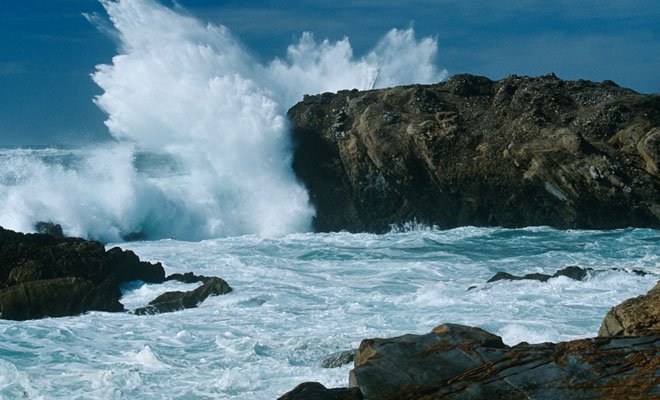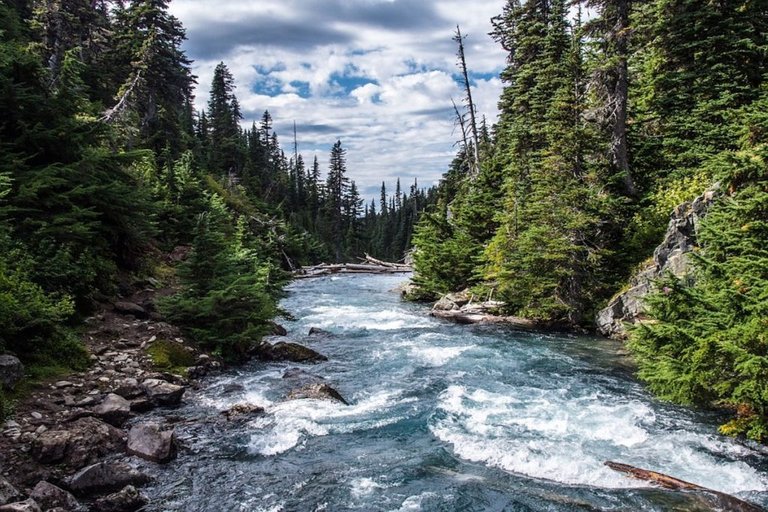
Secretos de la Tierra: El agua vence a la roca
¡Hola, hola, Hivernautas! Continuamos con la serie Los secretos de la Tierra. Viajando, mirando fotografías y viendo películas habrás observado que hay montañas con agudos picos, mientras otras son suaves y redondeadas. Las montañas del primer tipo son montañas jóvenes; se han formado hace poco tiempo. Las del segundo tipo son montañas viejas; se han formado hace muchos millones de años y el aire y el agua las han erosionado.
La erosión es el proceso por el que un terreno se desgasta y desintegra. Por la sedimentación, estos fragmentos se depositan formando capas. Así el conjunto erosión-sedimentación tiende a equilibrar el relieve terrestre, rebajando las montañas y rellenando los valles. Y parte importante de este trabajo le corresponde al agua.
El gran depósito de agua de la Tierra es el mar. El mar castiga duramente los acantilados de la costa, hasta que estos se desmoronan y se convierten en playas arenosas y llanas. Pero el trabajo más importante que hace el agua del mar para erosionar la tierra es, precisamente, evaporarse.
El agua evaporada asciende a grandes alturas y forma las nubes. El viento transporta las nubes y entonces estas descargan el agua sobre el terreno.

La erosión causa que la roca se disgregue en partículas más pequeñas. Créditos: imagen libre de Imgur.com
En las más altas montañas, el agua cae en forma de nieve, pero con las bajas temperaturas reinantes llega a helarse. Entonces, puede formar grandes depósitos de hielo que se desplazan lentamente hacia los valles, a modo de impresionantes ríos de hielo de curso lentísimo. Esas grandes masas de hielo en movimiento son los glaciares.
En su marcha lenta e implacable, los glaciares arrastran rocas que a lo largo de los siglos llegan a erosionar sensiblemente las montañas, ahondando valles que por su origen, se llaman valles glaciares.
Otro aspecto importante de la acción geológica del hielo es la acción erosiva que realiza cuando el agua penetra en las grietas de una roca y se hiela en su interior. El agua al congelarse aumenta de volumen, y la presión que ejerce entonces consigue cuartear las rocas. Este es el origen de muchos desprendimientos de rocas de montañas altas. Pero sin necesidad de convertirse en hielo, el agua desempeña una importante acción erosiva.

Los glaciares y sus características de erosión y deposición proporcionan evidencia clave sobre las glaciaciones pasadas y el cambio climático. Créditos: commons.wikimedia.org
Por una parte, el agua, combinada con la acción de los elementos atmosféricos, actúa químicamente sobre los terrenos. Esto se traduce no solamente en una transformación química, sino también en una disgregación.
En segundo lugar, el agua arrastra consigo la tierra, arena, guijarros y piedras. Estos materiales actúan como abrasivos y arrancan nuevos detritus que se unen a esta labor erosiva, hasta que el curso de la corriente se hace más lento y se depositan en forma de sedimentos.
El máximo exponente de la actividad erosiva del agua son los ríos. El agua de lluvia puede sufrir varios destinos: puede evaporarse rápidamente o ser absorbida por el suelo, pero lo más normal es que corra por la superficie terrestre formando arroyos y riachuelos. Estos formarán a su vez los ríos, que van a parar de nuevo al mar.
Las corrientes de agua se abren camino desde la montaña más alta hasta el mar, siguiendo los declives del terreno, bajando continuamente. A veces, un valle muy cerrado entre montañas le cierra el paso con una elevación, pero entonces el agua se remansa y forma un lago. De esta manera consigue subir su de nivel y superar el obstáculo.

Río donde se evidencia la fuerza de arrastre de grandes rocas y troncos, Créditos: Imagen libre pixabay.com
Al principio de su curso, mientras discurre entre las montañas más altas, el río es muy veloz y su acción erosiva, más profunda. El agua se abre camino como un cuchillo y los valles son más profundos. En esta zona se dice que el río sigue su curso alto, y es común que su recorrido esté salpicado de saltos y cascadas.
En el curso medio del río su caudal empieza a ser considerable por la aportación de los afluentes. Un afluente es un río que vierte sus aguas en otro cuyo caudal engrosa. Aunque en el curso alto de los afluentes que pueda tener un río están los riachuelos de montaña, estos son muy numerosos y de caudal muy rápido, por lo que en conjunto aportan cantidades considerables de agua. Por, eso en su curso medio, el río tiene una corriente impetuosa, de un volumen considerable. Esta potencia hace que pueda arrastrar una cantidad de piedras y gravas, por lo que paulatinamente va ensanchando el valle y su cauce.

Cataratas del Iguazú, Argentina y Brasil. Créditos: commons.wikimedia.org
Como vemos, el poder del agua se manifiesta tanto en las alturas como en las profundidades.
¡Hasta la próxima, Hivernautas!
Créditos:
Imagen 1: Autoría propia. Realizada con base en imágenes libres.
Imagen 2: Fuente
Imagen 3: Fuente
Imagen 4: Fuente
Imagen 5: Fuente
Fuentes de consulta:
- https://concepto.de/erosion-hidrica/
- https://twenergy.com/ecologia-y-reciclaje/medio-ambiente/que-es-la-erosion/
- https://www.geoenciclopedia.com/glaciares-44.html
- https://noticias.udec.cl/documental-de-investigador-de-incar-muestra-la-influencia-de-los-rios-en-el-oceano/
- https://www.euston96.com/cascada/
- https://www.clarin.com/new-york-times-international-weekly/nueva-hipotesis-origen-cascadas_0_AnIWgC20K7.html
English Edition

Earth Secrets: Water Beats Rock
Hello, hello, Winternauts! We continue with the series The secrets of the Earth. Traveling, looking at photographs and watching movies, you will have noticed that there are mountains with sharp peaks, while others are smooth and rounded. Mountains of the first type are young mountains; They have been formed for a short time. Those of the second type are old mountains; they have formed many millions of years ago and have been eroded by air and water.
Erosion is the process by which land wears away and disintegrates. By sedimentation, these fragments are deposited forming layers. Thus the erosion-sedimentation set tends to balance the terrestrial relief, lowering the mountains and filling in the valleys. And an important part of this work corresponds to water.
The great reservoir of water on Earth is the sea. The sea harshly punishes the cliffs of the coast, until they crumble and become sandy and flat beaches. But the most important job that seawater does to erode the land is precisely to evaporate.
The evaporated water rises to great heights and forms clouds. The wind carries the clouds and then they dump the water on the ground.

Erosion causes rock to break down into smaller particles. Credits: free image from Imgur.com
In the highest mountains, the water falls as snow, but with the prevailing low temperatures it freezes. Then, it can form large deposits of ice that move slowly towards the valleys, like impressive rivers of ice with a very slow flow. Those large masses of moving ice are glaciers.
In their slow and relentless march, the glaciers carry rocks that over the centuries significantly erode the mountains, deepening valleys that, due to their origin, are called glacial valleys.
Another important aspect of the geological action of ice is the erosive action it performs when water penetrates cracks in a rock and freezes inside. When water freezes, it increases in volume, and the pressure it then exerts manages to crack the rocks. This is the source of many high mountain rockfalls. But without needing to turn into ice, water performs an important erosive action.

Glaciers and their erosional and depositional features provide key evidence about past ice ages and climate change. Credits: commons.wikimedia.org
On the one hand, the water, combined with the action of the atmospheric elements, acts chemically on the land. This results not only in a chemical transformation, but also in a disintegration.
Second, the water carries with it dirt, sand, pebbles and stones. These materials act as abrasives and tear up new detritus that joins this erosive work, until the course of the current slows down and they are deposited in the form of sediments.
The maximum exponent of the erosive activity of water are the rivers. Rainwater can suffer several fates: it can evaporate quickly or be absorbed by the ground, but the most normal thing is that it runs over the earth's surface forming streams and streams. These will in turn form the rivers, which flow back into the sea.
The water currents make their way from the highest mountain to the sea, following the slopes of the land, descending continuously. Sometimes a very closed valley between mountains blocks the way with a rise, but then the water pools and forms a lake. In this way he manages to raise his level and overcome the obstacle.

River where the drag force of large rocks and logs is evident, Credits: Free image pixabay.com
At the beginning of its course, while it runs between the highest mountains, the river is very fast and its erosive action is deeper. The water cuts its way like a knife and the valleys are deeper. In this area it is said that the river follows its high course, and it is common for its route to be dotted with waterfalls and waterfalls.
In the middle course of the river its flow begins to be considerable due to the contribution of the tributaries. A tributary is a river that pours its waters into another whose flow swells. Although in the upper course of the tributaries that a river may have are mountain streams, these are very numerous and have a very fast flow, which is why together they provide considerable amounts of water. Therefore, in its middle course, the river has an impetuous current, of considerable volume. This power means that it can drag a quantity of stones and gravel, which is why it gradually widens the valley and its bed.

Iguazu Falls, Argentina and Brazil. Credits: commons.wikimedia.org
As we see, the power of water is manifested both in the heights and in the depths.
Until next time, Hivernauts!
Credits:
Image 1: Own authorship. Made based on free images.
Image 2: Fuente
Image 3: Fuente
Image 4: Fuente
Image 5: Fuente
Reference sources:
- https://concepto.de/erosion-hidrica/
- https://twenergy.com/ecologia-y-reciclaje/medio-ambiente/que-es-la-erosion/
- https://www.geoenciclopedia.com/glaciares-44.html
- https://noticias.udec.cl/documental-de-investigador-de-incar-muestra-la-influencia-de-los-rios-en-el-oceano/
- https://www.euston96.com/cascada/
- https://www.clarin.com/new-york-times-international-weekly/nueva-hipotesis-origen-cascadas_0_AnIWgC20K7.html
